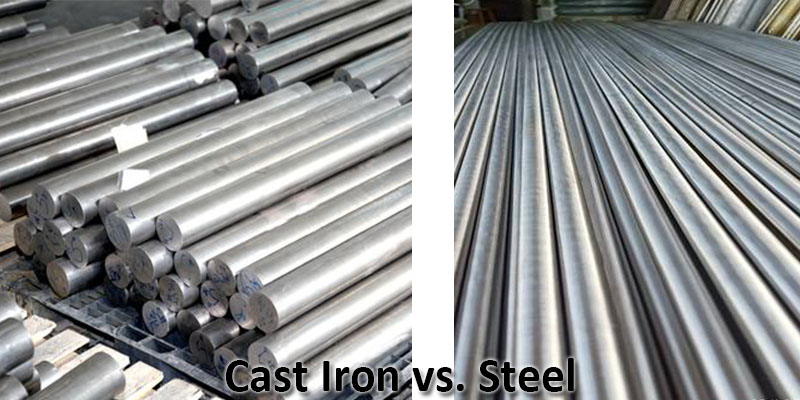In the field of CNC machining parts manufacturing, cast iron and steel are two common metal materials, each with unique physical and chemical properties, widely used in various industrial projects. This post explores the key differences between cast iron and steel, along with their respective advantages and disadvantages.
What is Cast Iron?
Cast iron is an iron carbon alloy with a carbon content greater than 2%, mainly composed of iron, carbon, and silicon. Cast iron is produced through casting technology and has excellent casting performance, which can produce various complex shaped parts. Cast iron has good shock absorption, wear resistance, and machinability, as well as cost-effectiveness, making it widely used in the mechanical, automotive, and shipbuilding industries.
What is Steel?
Steel is an iron carbon alloy with a carbon content ranging from 0.02% to 2.11%, and its chemical composition can be adjusted according to the performance requirements of different fields. Steel has high strength, high toughness, good plasticity, weldability, excellent corrosion resistance, and wear resistance. Steel, as a fundamental material in modern industry, is widely used in construction, bridges, machinery, automobiles, and shipbuilding.

Key Differences Between Cast Iron and Steel
1. Composition:
Cast Iron: Contains 2-4% carbon and various other elements like silicon, manganese, and sulfur. The high carbon content makes it brittle.
Steel: Typically has less than 2% carbon, with iron and other elements like manganese, chromium, and nickel. This lower carbon content gives steel its ductility and strength.
2. Manufacturing Process:
Cast Iron: Produced by melting iron and pouring it into molds where it solidifies into the desired shape.
Steel: Manufactured through various processes, including melting and casting, but also involves further refinement through techniques like rolling, forging, and extrusion.
3. Microstructure:
Cast Iron: Has a heterogeneous structure with graphite flakes or nodules embedded in the iron matrix, which can affect its mechanical properties.
Steel: Typically has a more uniform crystalline structure, contributing to its consistent mechanical properties.
Pros and Cons of Cast Iron
Pros:
High Compressive Strength: Excellent for applications requiring high compressive strength, such as columns, bridges, and heavy machinery bases.
Durability: Cast iron is highly durable and resistant to wear and deformation, making it suitable for heavy-duty applications.
Good Castability: Its ability to be cast into complex shapes with precise dimensions makes it ideal for intricate designs and components.
Vibration Dampening: The graphite structure in cast iron absorbs vibrations, making it useful for applications like engine blocks and machine tool frames.
Cons:
Brittleness: High carbon content makes cast iron brittle, leading to potential fracture under tensile stress.
Poor Tensile Strength: Not suitable for applications requiring high tensile strength and flexibility.
Corrosion: More prone to rust and corrosion than some types of steel, especially in moist environments.
Weight: Heavier than steel, which can be a disadvantage in applications where weight is a critical factor.
Pros and Cons of Steel
Pros:
High Tensile Strength: Steel’s lower carbon content and uniform structure provide high tensile strength, making it suitable for structural applications.
Ductility: Can be stretched and deformed without breaking, allowing for flexibility in design and manufacturing.
Versatility: Available in numerous grades and types, each with specific properties tailored for different applications.
Corrosion Resistance: Certain types of steel, such as stainless steel, offer excellent resistance to rust and corrosion.
Recyclability: Steel is highly recyclable, making it an environmentally friendly material choice.
Cons:
Cost: Generally more expensive than cast iron, especially specialized grades like stainless steel.
Complex Production: Requires more sophisticated production processes, which can increase manufacturing complexity and cost.
Thermal Conductivity: Lower thermal conductivity compared to cast iron, which can be a disadvantage in applications requiring heat dissipation.
Cast Iron vs. Steel: Which to Choose?
When choosing between cast iron and steel as materials for a project, it is necessary to consider the specific requirements of the project. Here are some suggestions:
If the project has high requirements for shock absorption and wear resistance of parts, and relatively low requirements for strength and toughness, cast iron may be a better choice. For example, parts such as bases and brackets in mechanical equipment can choose cast iron materials.
If the project has high requirements for the strength and toughness of parts, and needs to withstand large loads and impacts, steel may be a better choice. For example, key components such as building structures, bridges, and car frames should be made of steel.
Applications of Cast Iron and Steel
Cast Iron:
Automotive Industry: Engine blocks, cylinder heads, and brake discs.
Construction: Columns, pipes, and foundations.
Machinery: Machine tool frames, gearboxes, and heavy equipment bases.
Cookware: Skillets, pans, and griddles due to its excellent heat retention.
Steel:
Construction: Beams, columns, and reinforcement bars in buildings and bridges.
Automotive Industry: Car frames, body panels, and structural components.
Aerospace: Aircraft frames, engine components, and landing gear.
Consumer Goods: Appliances, tools, and electronics housings.
Conclusion
Choosing between cast iron and steel depends on the specific requirements of the application. Cast iron excels in situations where compressive strength, durability, and vibration dampening are critical. Steel, on the other hand, offers high tensile strength, ductility, and versatility, making it suitable for a wide range of applications. By understanding the differences, advantages, and disadvantages of each material, manufacturers and engineers can make informed decisions to meet their project’s needs effectively.



